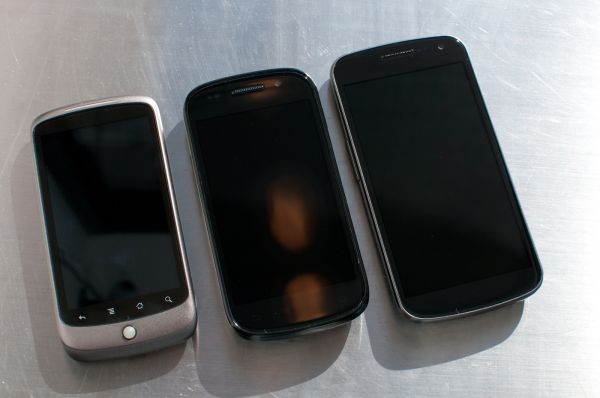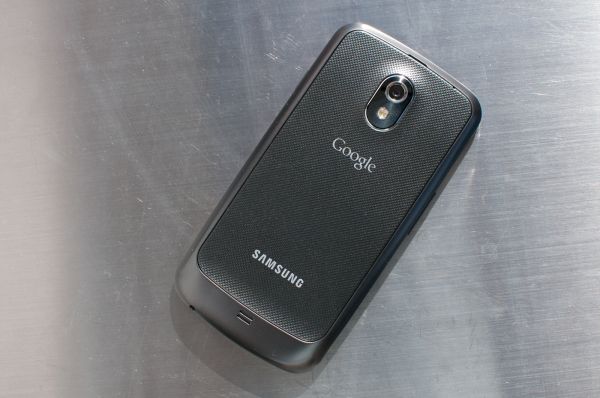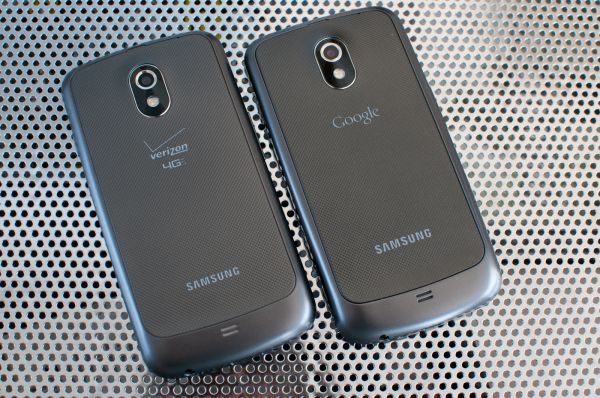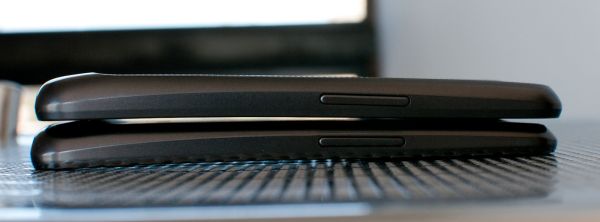Samsung Galaxy Nexus & Ice Cream Sandwich Review
by Brian Klug & Anand Lal Shimpi on January 18, 2012 1:34 PM ESTThe Galaxy Nexus - Hardware and Aesthetics
The evolution of Google’s Nexus line is an interesting one. Each year, Google choses both a silicon partner and an OEM to make a unique hardware archetype which it caters a specific build of Android to. We’ve now seen three Nexus handset designs from two OEMs and three silicon vendors - the Nexus One (HTC and Qualcomm’s QSD8x50), Nexus S (Samsung and Samsung’s S5PC110 ‘Hummingbird’), and today the Galaxy Nexus (Samsung and TI’s OMAP4460).
Looking at the hardware of those three handsets gives a great survey of the course the Android ecosystem has taken over the last couple of years. The Nexus One started things out with a 3.7” LCD, capacitive buttons, and hardware trackball. Nexus S then removed the trackball, added a curved 4.0” display, and ditched the microSD card slot. The Galaxy Nexus continues in that direction, increasing display size to 4.65” and resolution to 1280x720, and finally removing the capacitive buttons all together. Instead, the Galaxy Nexus uses a 96 x 720 region at the bottom of the display to visualize the navigational buttons, a move that has the consequence of also keeping the display interaction area aspect ratio close to that of WVGA.
It’s interesting to see how many of the design motifs set by the original Nexus One still have been thoughtfully preserved on the Galaxy Nexus. The notched chrome ring around the camera aperture has continued as a thread for three generations, as has the overall lightly rounded shape. The Galaxy Nexus also retains the chin from Nexus S backside where the speakerphone port and primary cellular antennas are located. In addition, the volume rocker, power/lock button, headphone jack, and primary microphone position from the Nexus S is unchanged.
The Galaxy Nexus’ backside is no longer the extremely slippery and scratch prone plastic that the Nexus S (and original Galaxy S) adorned, instead it’s a textured, lightly soft touch material. I’m always surprised by how much of a difference changing the backside texture makes on the overall in-hand feel impressions I come away with, and in this case it’s a major positive change. It’s clear that this is an evolution of Nexus more than a huge departure from what’s come before - if anything the Galaxy Nexus is like a larger, thinner, more refined Nexus S.
We’ve taken a look at both the CDMA/LTE (codename mysid/toro) and the GSM/UMTS (codename yakju/maguro) Galaxy Nexus variants.
The two differ beyond just the air interfaces they support slightly in the physical department as well, though the two share all the same other features (SoC, display, camera, etc.). The CDMA/LTE Galaxy Nexus is ever so slightly thicker than the GSM/UMTS Galaxy Nexus, though the difference is enough to be perceptible.
In addition, the two have the same exterior “titanium silver” color, no doubt the differences we saw earlier can be attributed to the difference between renders and the real deal. The other small detail is that the two use very different, non-interchangeable batteries - the GSM/UMTS variant uses a 6.48 Whr battery, the CDMA/LTE version gets a slightly larger 6.85 Whr battery. Both of these include the NFC antenna patterned the outside surface of the battery, just under the sticker.
Other than those subtle differences, Samsung has done a good job masking the challenges which underlie having two superficially similar phones with different cellular architectures. The two variants do feel different in the hand, but the difference isn't dramatic.
| Physical Comparison | ||||
| Apple iPhone 4S | Samsung Galaxy S 2 | Samsung Galaxy Nexus (CDMA/LTE) | Samsung Galaxy Nexus (GSM/UMTS) | |
| Height | 115.2 mm (4.5") | 125.3 mm (4.93") | 135.5 mm (5.33") | 135.5 mm (5.33") |
| Width | 58.6 mm (2.31") | 66.1 mm (2.60") | 67.94 mm (2.67) | 67.94 mm (2.67) |
| Depth | 9.3 mm ( 0.37") | 8.49 mm (0.33") | 9.47 mm (0.37") | 8.94 mm (0.35") |
| Weight | 140 g (4.9 oz) | 115 g (4.06 oz) | 150 g (5.3 oz) | 135 g (4.8 oz) |
| CPU | Apple A5 @ ~800MHz Dual Core Cortex A9 | 1.2 GHz Exynos 4210 Dual Core Cortex A9 | 1.2 GHz Dual Core Cortex-A9 OMAP 4460 | 1.2 GHz Dual Core Cortex-A9 OMAP 4460 |
| GPU | PowerVR SGX 543MP2 | ARM Mali-400 | PowerVR SGX 540 | PowerVR SGX 540 |
| RAM | 512MB LPDDR2-800 | 1 GB LPDDR2 | 1 GB LPDDR2 | 1 GB LPDDR2 |
| NAND | 16GB, 32GB or 64GB integrated | 16 GB NAND with up to 32 GB microSD | 32 GB NAND | 16/32 GB NAND |
| Camera | 8 MP with LED Flash + Front Facing Camera | 8 MP AF/LED flash, 2 MP front facing | 5 MP with AF/LED Flash, 1080p30 video recording, 1.3 MP front facing | 5 MP with AF/LED Flash, 1080p30 video recording, 1.3 MP front facing |
| Screen | 3.5" 640 x 960 LED backlit LCD | 4.27" 800 x 480 SAMOLED+ | 4.65" 1280x720 SAMOLED HD | 4.65" 1280x720 SAMOLED HD |
| Battery | Internal 5.3 Whr | Removable 6.11 Whr | Removable 6.85 Whr | Removable 6.48 Whr |






















185 Comments
View All Comments
zorxd - Thursday, January 19, 2012 - link
And what exactly is more efficient?c4v3man - Thursday, January 19, 2012 - link
Their implimention of pseudo-multitasking as opposed to the much more flexible multitasking in Android.erple2 - Friday, January 20, 2012 - link
Bingo!Since the iOS can't do "true" multitasking, primarily as a design decision on Apple's part to greatly improve battery life (seen the battery life numbers on WebOS? They're pretty terrible), the requirements for memory are generally quite a bit lower than for Android.
You could argue all day as to which one is better, and still not come up with a clear winner. This is strictly due to the phone form factor. Given the limitations on usable screen size (can't display 2 apps at once reliably), and that you have to rely on battery life, the argument of which is "better" is more difficult to make. These all disappear when power is no longer a serious concern (desktop), nor physical screen display (notebook through desktop).
zorxd - Friday, January 20, 2012 - link
yeah and DOS is better because it works fine with only 1MB RAM.OCedHrt - Friday, January 20, 2012 - link
Which is fine due to fast app switching.trob6969 - Wednesday, January 18, 2012 - link
You didn't have to sacrifice GPU performqnce for a 4.3 inch 720p HD display. You could have done what i did and got an htc rezound. I downloaded Dead space, which is probably one of the most GPU demanding games for a phone, and gameplay is FLAWLESS on it! ZERO choppiness throughout the game. My rezound plays this game just as smoothly as my playstation 3. That says a lot about a phone's performance.metafor - Wednesday, January 18, 2012 - link
Note that with the increased clockspeed to the SGX540, the OMAP4460 matches the GPU performance of a Snapdragon S3 (used in the Rezound).Both chips perform similarly with the CPU clock at 1.2GHz (compare Sensation 4G to GN, for example).
dwang - Wednesday, January 18, 2012 - link
Deadspace runs perfectly fine on the galaxy nexus. No choppiness or slowdown.Zoomer - Thursday, January 19, 2012 - link
TI probably didn't anticipate the move to such high resolutions. The 540 was probably chosen as a good enough solution, given the power reqs are well.This is where Apple's hardware-software codesign wins out.
Johnmcl7 - Wednesday, January 18, 2012 - link
That reasoning that microSD cards are too slow seems to only apply to some of the cheap phones which pretty only use micro SD storage, for a phone like the Nexus it doesn't matter as you say because the micro SD card is for storage rather than applications. I don't really understand why the Nexus doesn't get a harder time for the lack of microSD storage given the relatively low onboard storage and high spec which means it can play back high resolution video which needs quite a bit of space. It's one of the main reasons I went for the Note instead which has the better camera, faster GPU and the micro SD storage allowing me to add 32GB very cheaply (and more down the line when 64GB cards come down in price) which is pretty necessary as the high resolution video recording and other features chew through space very quickly.John